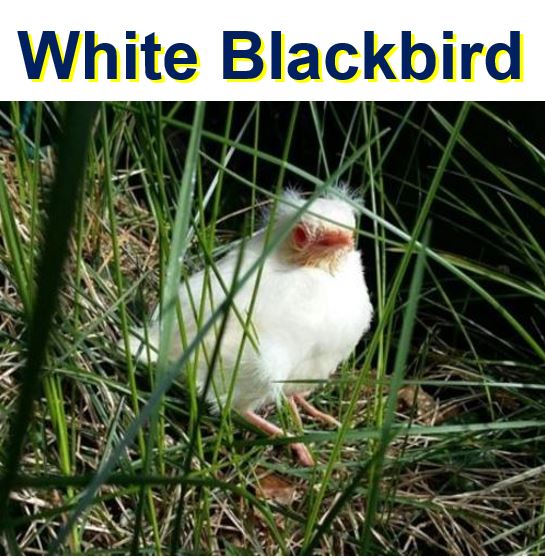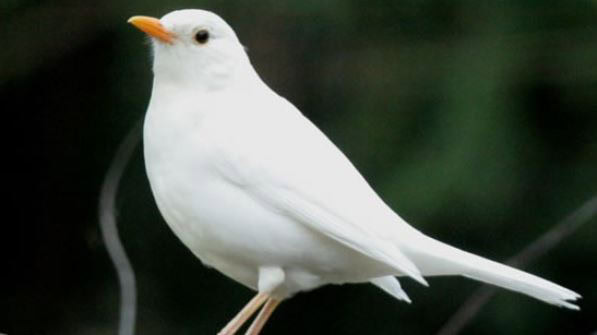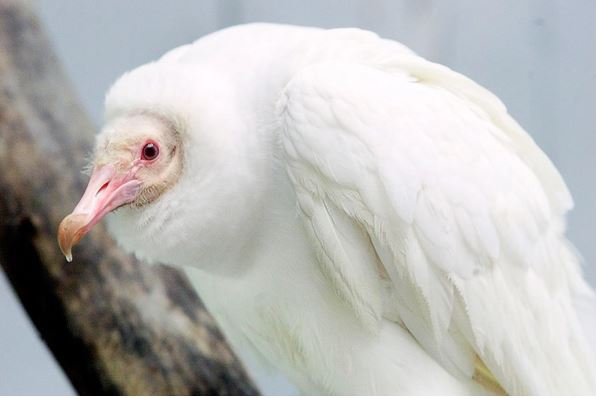An extremely rare albino blackbird or ‘white blackbird’ has been spotted in Hatherleigh, North Devon. Birds with albinism are not that rare, but because of their poor eyesight and lack of camouflage when the fledglings leave their nests, many do not usually survive for very long. In other words, their short average lifespans mean there are few of them about.
Jo Pullin, who has worked at conservation charity the Devon Wildlife Trust for the past fourteen years, said she spotted the amazing bird in her back garden.
She was first made aware of the presence of the strange-looking creature by her children, who told her they had seen something unusual moving about in the undergrowth at the edge of their garden.
 Ms. Pullin’s children first spotted the white blackbird moving around in the undergrowth. (Image: devonwildlifetrust.org)
Ms. Pullin’s children first spotted the white blackbird moving around in the undergrowth. (Image: devonwildlifetrust.org)
Ms. Pullin said:
“My children and I spotted something unusual in the undergrowth at the edge of our garden. We went to investigate and soon discovered it was a white blackbird. It looked like it had only just recently left the nest.”
“I’ve seen birds with odd colouring before, but never a completely white blackbird. It really stood out and looked very vulnerable.”
Birds with unusual colouring
Over the past twenty years, ornithologists say that the number of reported sightings of bizarre-looking birds which defy expectations has increased considerably, from blackbirds which are brilliant white to house sparrows covered all over with shocking pink feathers.
The phenomenon, which is often the result of varying degrees of albinism, affects many of the most common bird species, including several that are known for their distinctive colourings, such as robins or red kites.
 This adult male white blackbird has done well – albinistic birds rarely make it to adulthood. (Image: RSPB)
This adult male white blackbird has done well – albinistic birds rarely make it to adulthood. (Image: RSPB)
Sightings of robins without their famous red plumage are occurring more frequently, as are those of red kites with no red on them.
Across the UK there have been reports of moorhens, coots and crows with all white rather than black feathers.
However, what was extremely rare about the bird that Ms. Pullin and her children spotted was its total lack of colour – even its eyes.
This bird is a ‘true albino’, a condition which is much more unusual (most cases are of partial-albinism).
White blackbirds and their hostile environment
This white blackbird recently spotted in North Devon has been extremely lucky to have survived for as long as it has. It’s unusual looks and poor vision do not usually bode well. Pure albino fledglings stand out and are easy pickings for cats and birds of prey.
Regarding the survival chances for pure albino birds, Steve Hussey, who also works at the Devon Wildlife Trust, said:
“Being pure white isn’t a great survival strategy for a blackbird, particularly as a fledgling. When you’ve just left the nest you want to be as inconspicuous as possible to avoid the predatory eyes of cats and sparrowhawks.”
“Added to this, part of the condition of albinos often means they have poor or little eyesight. I fear that this little chap’s life was probably a very brief one.”
 Lack of colouring in parts of the body, rather than all over, is much more common among birds. The oystercatcher on the left has some dark feathers, it is not white all over. The oystercatcher’s typical colouring can be seen on the picture on the right. (Images: Left – RSPB. Right – Wikipedia)
Lack of colouring in parts of the body, rather than all over, is much more common among birds. The oystercatcher on the left has some dark feathers, it is not white all over. The oystercatcher’s typical colouring can be seen on the picture on the right. (Images: Left – RSPB. Right – Wikipedia)
Ms. Pullin and family searched for the white blackbird the next day but could not find it, in fact, they have not seen it since it was first spotted. Let’s hope Mr. Hussey’s prediction of its unpromising future is wrong.
At this time of year – Spring – more baby birds can be seen in our gardens. Despite their vulnerability, Devon Wildlife Trust urges people to leave them well alone. If you want to help, try keeping cats and dogs away.
Albinism in birds
According to the RSPB (Royal Society for the Protection of Birds), albinism describes birds in which some or all of the normal pigmentation is missing. In most cases it is inherited, but can sometimes be caused by other factors.
It is a recessive feature – this means that it only shows up when a fledgling inherits the albino gene from both parents.
 An albino Black Vulture is a very rare find. Audubon (a large US conservation society) writes: “When it comes to identifying albino birds, feathers can be deceptive. So if you see a white bird at your feeder, remember that the eyes don’t lie.” (Image: audubon.org)
An albino Black Vulture is a very rare find. Audubon (a large US conservation society) writes: “When it comes to identifying albino birds, feathers can be deceptive. So if you see a white bird at your feeder, remember that the eyes don’t lie.” (Image: audubon.org)
Degrees of albinism can range from just a few white feathers on an otherwise normal coloured bird to all-white feathers.
True albinos have no colouring in all feathers and soft parts. Their feathers are completely white, while their legs, eyes and bill (beak) are pink.
The RSPB says:
“True albinos are normally less robust in other ways and often have deficient eyesight and hearing. They rarely survive for long, and therefore are only rarely seen.”
“Most reported albinos have normal eye, bill and leg colouration. Being generally conspicuous, they are more likely to fall prey to predators. Some albinos are shunned by other birds and will find it difficult to obtain a mate, but this is not always so.”
“Partial albinism is caused by the failure of pigmentation to reach certain feathers. While this is often hereditary, other factors such as unbalanced diet, old age and injury, or even disease and shock can cause albinism. In hereditary cases the white pattern is consistent from one moult to another, but albinism caused by environmental factors is often reversible.”
Leucism is a condition where there is partial loss of pigmentation in birds and other animals (not the eyes). Unlike albinism, it is caused by a reduction in several types of pigment, not just melanin.
Video – 22 amazing and rare albino animals
